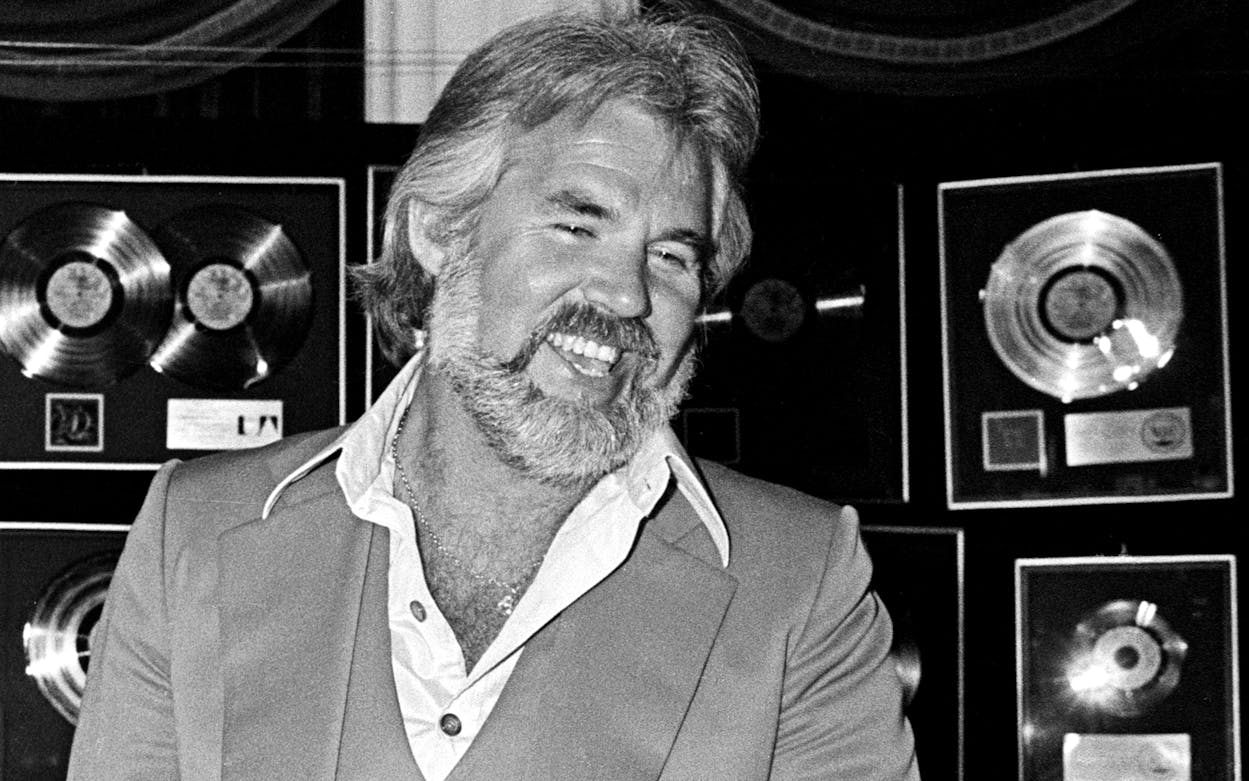Kenny Rogers, who died yesterday in Georgia at the age of 81, will always be known as a country singer—one who sold more than 150 million albums over a 65-year career. But before the Texan found success as a mainstream country artist, he spent years playing blues, jazz, folk, and idiosyncratic rock and roll.
Rogers was born in Houston on August 21, 1938. The fourth of eight children, he grew up on the outskirts of the Fourth Ward in the San Felipe Courts, which were houses built for white defense workers and their families. His father was a carpenter and his mother a nurse’s assistant.
As a boy, Rogers loved to sing and did so in local church choirs and glee clubs. The tall, handsome teen with a long face and brown hair worked as a busboy at the Rice Hotel, where he earned enough money to buy himself a guitar. Soon he was singing in a doo-wop group called the Scholars; one of his bandmates was high school buddy Mickey Newbury. The group recorded a few songs that Kenny’s older brother, Lelan, produced; he would later start a label called International Artists and produce the seminal psychedelic Austin band 13th Floor Elevators.
Singing high and sweet, Kenneth Rogers—as he styled himself then—had a Houston hit in 1957 with a doo-wop song, “That Crazy Feeling.” It became a big enough hit to get him his first invitation to American Bandstand.
By 1960 he was playing bass and singing in a trio with the blind jazz pianist and vocalist Bobby Doyle. The group performed jazz and blues standards and accompanied performers like Liza Minnelli and Tony Bennett. The trio worked and worked, sometimes playing twelve hours a day—happy hour gigs, then nightclub gigs, then after-hours gigs. From those experiences, Rogers learned to play and sing just about anything. He performed with Doyle until 1965, but by then he had caught the attention of the well-scrubbed folk group the New Christy Minstrels, who were looking for a bass player who could sing the high notes.
Rogers was only in the group for a year. By 1967’s Summer of Love, Rogers and other members of the band felt stifled by folk music and left to form the decidedly more groovy, downright psychedelic combo The First Edition. Rogers played bass and sang lead on their 1968 bad-acid-trip anthem, “Just Dropped In (To See What Condition My Condition Was In)”—written by Rogers’s childhood friend Newbury.
Still, Rogers never seemed completely comfortable in the rock and roll counterculture. By the time the group morphed into Kenny Rogers and the First Edition, he had a little gray in his beard and looked older and squarer than the kids vibing to the band. Rogers wanted to sing country, and the group’s next hit was the huge country song, “Ruby, Don’t Take Your Love to Town.”
In the mid-seventies Rogers landed in Nashville—and found his voice as a country singer, in turn leaving his youthful ways behind. The giant country hits followed—“Lucille,” “The Gambler,” “Coward of the County”—then, the pop hits—“Don’t Fall in Love With a Dreamer,” “Lady,” and “Islands in the Stream”—though Rogers was doing as much as any other singer to bring the two forms together. Through this, he became America’s quintessential warm and nostalgic voice; in 1986, USA Today and People magazine readers voted him their Favorite Singer of All Time. Even after he stopped making hits (his final one was “Buy Me a Rose” in 2000), he still made hit records, like 21 Number Ones—an album he released in 2006 of an astounding 21 number-one hits that broke the country top ten when he was 67 years old.
Rogers never took himself too seriously, even after his disastrous 2006 plastic surgery, which he regretted but also laughed about. “I had the money to do it,” he said in an interview, “and I had time off.” After he died at home in Georgia last night, the tributes poured in from friends. “Above all the music and the success,” tweeted Dolly Parton, “I loved him as a wonderful man and a true friend.”
Rogers was most known for “The Gambler,” a song about an older man counseling a younger one on learning to play the game of life: knowing when to hold ’em and when to fold ’em. Rogers certainly learned the game.
As he told Texas Monthly‘s Andy Langer in 2013, when he was a boy he would walk through the nicer neighborhoods in Houston and admire the water sprinklers he saw there. They became a totem of success, so when Rogers finally made it and built his own eighteen-hole golf course near his home in Georgia, he installed sprinklers everywhere. “I’d spend hours sitting on a golf cart admiring them,” he said.
Correction 3/21: A previous version of this article stated that Kenny Rogers’s birth date was August 28th, 1938. It has been amended to reflect that his birthday was August 21st, 1938.
- More About:
- Music
- Obituaries
- Country Music








